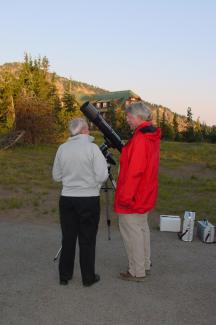See "The night sky in the world Home Page" for an excellent interpretation of what we observe about light pollution from satellite imagry.
How do we measure the darkness of our skies? The Bortle Dark-Sky Scale (high-resolution image)
Here is a summary article on Dark
and Starry Night Skies in Our National Parks.
The ecological perspective of our need to preserve our Dark Skies is covered in a new book, selected as an Editor's Choice by the Natural History Book Service. This book is Ecological Consequences of Artificial Night Lighting. The ecological perspective is also discussed in an article by the same authors, entitled Ecological Light Pollution.
For more information on protecting our National Parks, see what the Crater Lake Institute is doing.
For a wealth of more general information, see what the International Dark-Sky Association is doing. Don't miss example light fixtures designed for responsible lightning at the IDS site.
Checkout the Light Pollution Awareness Website for light pollution news and progress!
The Citizens for Responsible Lighting (CRL) is a nonprofit member based organization formed for the advancement of public awareness leading to light pollution and obtrusive outdoor lighting reform. Their mailing list, if you want to join, is on Yahoo.
For more email updates, consider the DarkSky-list -- a Light Pollution information forum and discussion group seeking members and offering methods for affecting Light Pollution reform.
TAO folks were at Crater Lake Institute's sidewalk astronomer program during daylight set-up.CLI sponsored public service viewings from August 18 through the 31st. From August 18th through the 31st members of the Crater Lake Institute engaged in public-service sidewalk astronomy at the Rim of Crater Lake. The response from the public was outstanding. Crater Lake is one of 10 best stargazing sites.
Link to Chad Moore's 2003 Dark Sky work.
Link to a great 2002 Dark Sky article.
